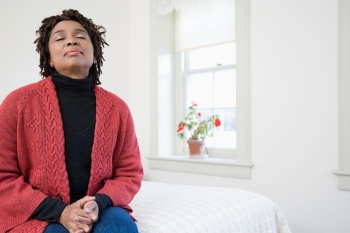
Anxiety sits at an uncomfortable intersection of two thoughts: that something is wrong, and that we can and should correct it. Anxiety keeps us focused on the future and the past: we replay over and over again past events we wish we could do-over, or fixate on all the ways (preventable and not) that things might go poorly for us in the future. Many believe that the way to get rid of anxious feelings is to try to fix the thing that’s bothering you. For instance, if you can’t fall asleep because you are worried about the emails you have to send at work the next day, your anxiety may push you to stay up all night making lists or planning out email content. Your anxiety tells you that this is the best way to resolve your anxious feelings: if you make lists you won’t forget any of the important emails you have to send! If you plan out email drafts, you’ll be able to get the tone just right! But in reality, you are increasing your anxious feelings by depriving yourself of sleep, and making it more likely you’ll make a mistake in the morning. It feels counter-intuitive, but in order to truly diminish your anxious feelings, you need to move out of past- and future-oriented thinking, and focus on the present. Instead of staying up late thinking anxious thoughts, you need to re-focus on the present, fall asleep, and trust that you can create time for this preparatory work in the morning.
This can be difficult when your brain is whirring with anxious thoughts. Using logic (“I have no control over what my coworkers feel” or “I can’t change the past”) on it’s own won’t stop your anxious thoughts. You need to re-ground yourself using your body and senses to stay in the present moment. You can use the I See/I Hear/I Feel exercise to do so on your own, or even silently in public spaces.
- Sit or stand still. Allow your gaze to become a “soft focus”, so that you are able to take in the objects in your direct line of vision and your periphery, without looking for interesting things to look at.
- Say, out loud: “I see ____.” Fill in the blank with something in your line of vision. Repeat this 5 more times. You might only see one thing and say it five times, you might see five separate things. The important thing is to accurately describe your visual experience in this moment, not to locate five interesting visual objects.
- Move on to sound. Say, out loud: “I hear ___.” Fill in the blank with something you hear. You can close your eyes if that helps you tune in to sounds around you better. Repeat this 5 more times. Again, you might hear five different sounds, you may hear only sound and repeat it 5 times. Either way is correct.
- Move on to touch. Say, out loud: “I feel ___.” Fill in the blank with something you feel, like your back against your chair or your fingers against your pants. Close your eyes if it helps you to tune into the sensations in your body. Repeat this 5 more times.
Continue the countdown. List 4 things you see, hear and feel. Then list 3 things you see, hear and feel. Then 2 of each, then one of each. This can look like:
5
- I see the box. I see the door. I see the wall. I see the floor. I see the box.
- I hear the fan. I hear the traffic. I hear the crickets. I hear the fan. I hear the fan.
- I feel my arm on the chair. I feel my ankle on my leg. I feel my fingers on my lap. I feel my arm on the chair. I feel my lips pressed together.
4
- I see the box. I see the door. I see the tape. I see the doorknob.
- I hear the fan. I hear the traffic. I hear a car radio. I hear a car radio.
- I feel my back against the chair. I feel my ankle on my leg. I feel my breath. I feel my arm against the chair.
3
- I see the floor. I see the box. I see the floor.
- I hear the fan. I hear traffic. I hear the birds.
- I feel my foot on the chair. I feel my ankle on my leg. I feel my arm on the chair.
2
- I see the box. I see the floor
- I hear a car radio. I hear the fan
- I feel my ankle on my leg. I feel my back against the chair.
1
- I see the box
- I hear the fan
- I feel my back against the chair.
You may have different experiences each round, you may have the same sensations repeating through all five rounds. There is no right way to do the exercise. The focus is on tuning into the sensations in your body in this present moment. If you get to 1 and still feel anxious, begin the exercise again at 5, and repeat until your anxiety has decreased.
This is an activity you can use in two ways: first, it’s helpful to do on a daily basis (before you leave for work in the morning, or when you get home). Doing a mindfulness exercise like this one on a regular basis can help train your brain to be better at being present. Think of this like building a muscle. The more regularly you “work out” your ability to stop fixating on the past or future, the easier it will be during moments of duress or high anxiety. You can also use the exercise while lying in bed, as a way to slow down your mind and get ready for sleep.
If you would like further exercises to manage your anxiety, book an appointment with a therapist at the Center for Growth today.















